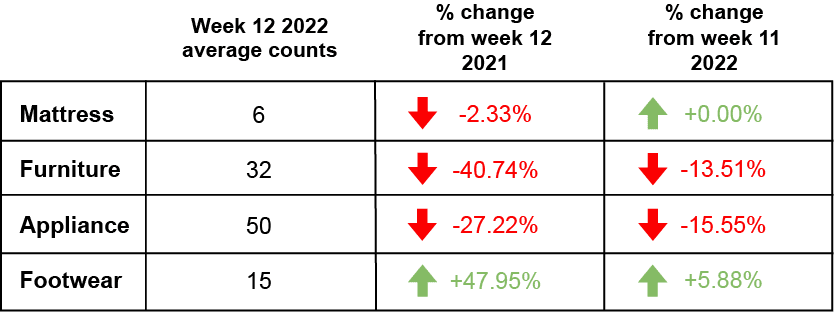
This week we discuss visual commerce and what different retail industries can learn from other sectors.
The pictures you display on your store windows and website, and the quality of the content has a major impact on getting customers across the buying line.
Customers are twice as likely to purchase a product if it has a 3D product image rather than a flat image.
THIS WEEK’S HIGHLIGHTS
- Doorcounts webinar: Our weekly webinar is back in action! Join us at 9 AM PST / 12 PM EST as we go over the Dashboard.
- Visual commerce strategies: How brands can use visual commerce strategies to better connect with consumers.
Furniture industry: What can the furniture industry learn from another sector?
FOOT TRAFFIC INDEX
Here’s a look at last week’s foot traffic compared to the same time last year.

FOOT TRAFFIC TRENDS
Industry insights so you can convert your foot traffic into more sales.
Visual Commerce Strategies To Better Connect with Consumers
Just as you would greet a customer at your physical store, you now need to greet your customers as soon as they enter your digital storefront by deploying effective visual commerce strategies.
The term “visual commerce” refers to the strategies and tactics around using pictures, videos, animations, and even augmented and virtual reality (AR and VR) to better engage and connect with consumers as they learn about your products and brand.
The pictures you display on your website, and the quality of the content has a major impact on getting customers across the buying line.
84% of consumers say that they’ve been convinced to buy a product or service by watching a video. More recently, images and videos have even evolved further to be three-dimensional — and customers are twice as likely to purchase a product if it has a 3D product image rather than a flat image.
What can the furniture industry learn from another sector?
As the retail industry as a whole, and more specifically the furniture industry, continues to change, Retail Dive sat down with various store owners to ask what they think could be learned from other industries.
John Conroy of Morrisofa Europe says, “The tech sector sells a full concept rather than a product – for example, buying an apple iPhone usually leads to buying Airpods, an iPad, apple Watch, and iPod to go with it. Why do we only try to sell a sofa, rather than a professionally designed roomset?”
Another owner pointed out the importance of supplier-driven assets. Mike Whitman, the owner of Iconography, states “Decent photography is an expensive investment, and proper 3D models are even more costly. Small independents simply can’t afford to source this themselves, either in time or money. If suppliers want their products to be chosen over their competitors (either by the end-customer or by retailers), then they need to be providing that retailer support.”
Each industry provides a unique take on what is going on in their world, and how the industries overlap and can learn from each other.
Click HERE to hear more about what can be learned from other industries.
Retail Snippets
price of return: Smart tech is tackling the true cost of returns to the retail industry.
retail science: Neuroscience-backed steps for persuasive virtual sales presentations.
Coin collection: Retail and financial trade groups in search of coins amid a shortage.
RANDOM IRRELEVANCE
Brick by brick: How Lego continues to build a toy empire.
Imperfect: The longest an NCAA bracket has ever stayed perfect.
Pluto: Scientists conclude that Pluto’s peaks are ice volcanoes.
